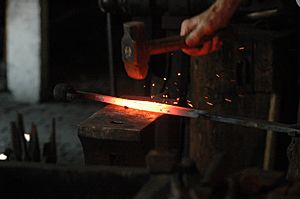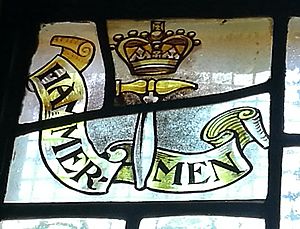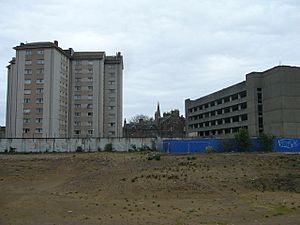Robert Garnock facts for kids
Quick facts for kids Robert Garnock |
|
|---|---|

Stirling Hammerman
|
|
| Religion | Christianity |
| School | Presbyterianism |
Robert Garnock (born around 1660 – died 1681) was a brave Scottish covenanter. Covenanters were people who promised to follow their Presbyterian Christian beliefs, even if the government disagreed. Robert was baptized by a famous minister named James Guthrie. Like Guthrie, Robert was later executed in Edinburgh, though at a different time and place. Guthrie was executed about 20 years before Robert.
Contents
Robert's Early Life in Scotland
Robert Garnock grew up in Stirling, Scotland. His father was a blacksmith, and Robert followed in his footsteps. He even helped build parts of the town's defenses.
In 1662, the government changed how the church was run in Scotland. They brought back bishops, a system called episcopacy. But Robert and many others preferred the Presbyterian way, which didn't have bishops.
Robert often attended secret Presbyterian church meetings called "conventicles." In 1678, the government wanted him to join their army. Robert refused because of his beliefs. To avoid being arrested, he had to leave Stirling.
He traveled to places like Glasgow and Falkirk, working as a blacksmith wherever he could. But he eventually returned to Stirling. In May 1679, he was part of a small fight with soldiers called dragoons. This happened at a conventicle near Fintry.
Capture and Time in Prison
After the fight, Robert tried to go back into Stirling. But he was caught and put in prison. He stayed there for a long time. In July 1680, he was moved with many other prisoners to Edinburgh.
They were held in the Greyfriars churchyard. This was a small, walled area where nearly 1,500 prisoners were kept. Most of them had been captured after the Battle of Bothwell Bridge. Robert worked hard to encourage his fellow prisoners not to give in to the government's demands.
Robert's Trial and Sentence
On October 25, 1680, Robert was taken for questioning. He refused to answer questions that would make him look guilty. Because of this, he was moved to the Tolbooth prison in Edinburgh.
He stayed there, refusing to change his mind, until October 7, 1681. He was brought before the Privy Council, a group of important government officials. Robert refused to accept the king's authority over his religious beliefs. For this, he was found guilty of treason. He was sentenced to be executed just three days later, on October 10.
Robert's Final Moments and Burial
Robert Garnock's sentence was carried out at a place called the Gallowlee. This area is now near the Pilrig junction, between Edinburgh and Leith.
After his execution, Robert's body was buried at the foot of the gallows. However, during the night, a Covenanter named James Renwick and some friends secretly moved the body. They reburied it in the West Church burying-ground in Edinburgh.
Later, in 1728, some parts of Robert's remains were accidentally found in a garden in Lauriston. They were then reburied with great respect in Greyfriars churchyard, close to the Martyrs' Tomb.
While he was in prison, Robert Garnock wrote about his life. Parts of his writings were later published in a book called 'Biographia Scoticana, or Scots Worthies' by John Howie. His final words and beliefs were also printed in a collection called 'Cloud of Witnesses'.




